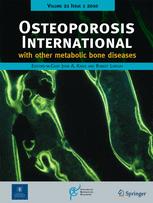Osteoporos Int:糖皮质激素使用增加骨折风险
2013-04-15 Osteoporos Int dxy
全身性糖皮质激素使用,定义为持续使用超出生理剂量的糖皮质激素达90天或以上,是低骨矿密度(BMD)和骨折的危险因素。但这个定义没有区分近期接触和远期接触。为此,来自加拿大阿尔伯塔大学医学系的Majumdar SR教授及其团队进行了一项研究,该研究发现近期和长期糖皮质激素使用与BMD减少和骨折风险增加独立相关。该研究结果在线发表在2013年4月10日的《国际骨质疏松症》(Osteoporosis I
全身性糖皮质激素使用,定义为持续使用超出生理剂量的糖皮质激素达90天或以上,是低骨矿密度(BMD)和骨折的危险因素。但这个定义没有区分近期接触和远期接触。为此,来自加拿大阿尔伯塔大学医学系的Majumdar SR教授及其团队进行了一项研究,该研究发现近期和长期糖皮质激素使用与BMD减少和骨折风险增加独立相关。该研究结果在线发表在2013年4月10日的《国际骨质疏松症》(Osteoporosis International)杂志上。
该研究在加拿大曼尼托巴省的以人群为基础的临床BMD登记处,确定了所有在1998年至2008年期间检测SMD的40岁以上的成年人,然后进行一项队列研究。鉴定了从1995年到2009年期间所有口服糖皮质激素的配方,并按使用时间(如果12月以内为“近期”,相对于“远期”)和持续时间(短程[<90天],长期[≥90天])对接触情况分层。利用健康管理数据获取骨质疏松相关危险因素和治疗,以及主要骨折。
该研究结果表明,在52070例个体中,共有12818例(25%)在检测BMD之前使用糖皮质激素;最常见的接触是远期短程(n=6453)vs近期长期(n=2896)vs近期短程(n=2644)vs 远期长期((n=825)。与39252例从未使用者相比,仅有近期长期糖皮质激素使用与股骨颈T值显著相关(校正差异ANCOVA为–0.13,95%CI –0.16至–0.10,P<0.001)。在中位数为5年的随访期间,有2842例主要骨折(566例髋关节骨折)。与从未使用者相比,仅有近期长期糖皮质激素使用与独立于BMD的主要骨折发生(5.4vs7.7%,校正HR 1.25,95%CI 1.07–1.45,P=0.004)和髋关节骨折发生(1.1vs1.8%,校正HR 1.61,95%CI 1.18–2.20,P=0.003)的风险增加显著相关。
该研究发现,近期和长期的糖皮质激素使用(但既不是远期的,也不是近期单程使用)与BMD减少和骨折风险增加独立相关。这个发现可以帮助临床医生确定那些可以从骨质疏松预防中获益的高危组患者。
与乳腺癌相关的拓展阅读:
- JCO:适量饮酒有利于乳腺癌女性患者生存
- Reuters:辉瑞乳腺癌新药palbociclib获FDA重大突破药物认定
- 饮酒不影响乳腺癌患者的生存
- Lancet Oncol:手术范围、超重或肥胖影响术后乳腺癌患者上臂淋巴水肿的发病率
- JNCI:雌激素联合黄体酮会增高乳腺癌发病率
- JNCI:高脂饮食增加乳腺癌患者死亡率 更多信息请点击:有关乳腺癌更多资讯

Influence of recency and duration of glucocorticoid use on bone mineral density and risk of fractures: population-based cohort study.
Abstract
Although systemic glucocorticoids are commonly used, it is difficult to obtain accurate exposure history. In 50,000 patients, we confirmed that glucocorticoids were associated with reductions in bone mineral density (BMD) and increases in fracture and documented that recent and prolonged durations of exposure were particularly associated with adverse events-dose information did not improve risk prediction.
INTRODUCTION
Systemic glucocorticoid use, defined as ever having taken supra-physiologic doses for 90-days or more, is a risk factor for low BMD and fractures. This definition does not distinguish recent (vs remote) exposure.
METHODS
Within a population-based clinical BMD registry in Manitoba, Canada, we identified all adults over age 40 years tested between 1998 and 2007 and then undertook a cohort study. We identified all oral glucocorticoid dispensations from 1995 to 2009 and stratified exposure by timing ("recent" if within 12 months vs "remote") and duration (short [<90 days] vs prolonged [≥90 days]). Osteoporosis-related risk factors and treatments and major fractures were obtained using administrative health data.
RESULTS
A total of 12,818 of 52,070 (25 %) subjects had used glucocorticoids prior to BMD testing; the most common exposure was remote short (n = 6453) vs recent prolonged (n = 2896) vs recent short (n = 2644) vs remote prolonged (n = 825). Compared to 39,252 never-users, only recent prolonged glucocorticoid use was significantly associated with femoral neck T-score (ANCOVA-adjusted difference -0.13, 95 % CI -0.16 to -0.10, p < 0.001). There were 2,842 major (566 hip) fractures over median 5-year follow-up. Compared with never-users, only recent prolonged glucocorticoid use was significantly associated with BMD-independent increases in risk of incident major fracture (5.4 vs 7.7 %, adjusted HR 1.25, 95 % CI 1.07-1.45, p = 0.004) and hip fracture (1.1 vs 1.8 %, adjusted HR 1.61, 95 % CI 1.18-2.20, p = 0.003).
CONCLUSIONS
Recent and prolonged glucocorticoid use (but neither remote nor recent short courses) was independently associated with reduced BMD and increased risk of fractures. These findings should permit clinicians to identify a high-risk group of patients that might benefit from osteoporosis prevention.
本网站所有内容来源注明为“梅斯医学”或“MedSci原创”的文字、图片和音视频资料,版权均属于梅斯医学所有。非经授权,任何媒体、网站或个人不得转载,授权转载时须注明来源为“梅斯医学”。其它来源的文章系转载文章,或“梅斯号”自媒体发布的文章,仅系出于传递更多信息之目的,本站仅负责审核内容合规,其内容不代表本站立场,本站不负责内容的准确性和版权。如果存在侵权、或不希望被转载的媒体或个人可与我们联系,我们将立即进行删除处理。
在此留言








#糖皮质#
66
#ROS#
64
#骨折风险#
72
#皮质激素#
54